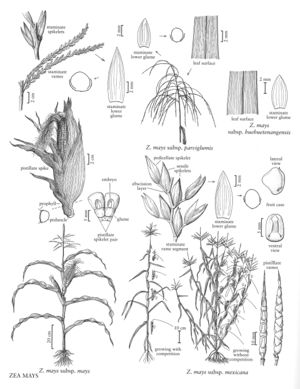Difference between revisions of "Zea mays subsp. parviglumis"
imported>Volume Importer |
imported>Volume Importer |
||
| Line 37: | Line 37: | ||
|publication year= | |publication year= | ||
|special status= | |special status= | ||
| − | |source xml=https://bitbucket.org/aafc-mbb/fna-data-curation/src/ | + | |source xml=https://bitbucket.org/aafc-mbb/fna-data-curation/src/200273ad09963decb8fc72550212de541d86569d/coarse_grained_fna_xml/V25/V25_1669.xml |
|subfamily=Poaceae subfam. Panicoideae | |subfamily=Poaceae subfam. Panicoideae | ||
|tribe=Poaceae tribe Andropogoneae | |tribe=Poaceae tribe Andropogoneae | ||
Revision as of 17:58, 11 May 2021
Culms (0.5)2-4 m, unbranched or branched above the middle, thinner than in subsp. mexicana. Leaves pubescent. Fruitcases 5-8 mm long, 3-5 mm wide. Caryopses concealed. Staminate panicles with (2)10-100(235) slender, often drooping branches; spikelets 4.6-7.2 mm, distant. 2n = 20.
Discussion
Zea mays subsp. parviglumis, which has the smallest fruitcases of all the wild taxa, is endemic to the Pacific slope of southern Mexico, from Oaxaca to Jalisco, being most abundant in the Balsas River drainage. It grows in highly seasonal, sunny thorn scrub, and open tropical deciduous forests and savannahs, at elevations of (450)600-1400(1950) m. One of its higher elevation populations appears to be the ancestor of subsp. mays. In the southern United States, Z. mays subsp. parviglumis is grown as part of breeding programs. In its native habitat, it tends to be seasonally isolated from subsp. mays, flowering a few weeks later, but the two sometimes form abundant hybrids in local areas.
Selected References
None.
